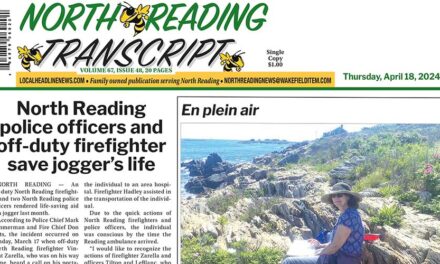Published November 19, 2020
By MAUREEN DOHERTY
NORTH READING — The Select Board voted 3-0 with two abstentions not to split the tax rate between residential property and commercial, industrial and personal property (CIP) at Monday night’s annual tax classification public hearing.
This was not a surprise because the town has only split the tax rate twice in the past, back in 1985 and 1988. Splitting the tax rate does not increase the amount of tax revenue the town would generate, it simply shifts the burden from one tax classification to another. According to Debbie Carbone, the town’s chief assessor, state statute allows a community to increase the CIP share of the tax levy to be up to 50% higher than the residential rate.
However, such shifts are typically done in communities that have a much larger CIP tax base than North Reading where 87.59% of the property is classified as residential and only 12.41% is classified as CIP, she said. Another requirement that must be met if a community chooses to shift the tax burden from residential to CIP is that the shift cannot exceed the town’s minimum residential factor, which is the same as the percentage of its residential property. Therefore, the maximum shift the town could impose would be 12.41% if the tax rate was split, Carbone explained.
In North Reading, according to the figures Carbone provided to the board, there are 5,422 parcels of land classified as residential. Of those, 4,288 are single family homes with an average single family home value increasing to $615,632 in FY21. Of the remaining residential parcels, 857 are condominiums, 46 are multi-family homes with up to five units, 23 are mixed-use properties and 208 are residential vacant land.
The town’s current single tax rate for FY20 is $15.60 per thousand dollars of valuation.
One surprise that did occur Monday night turned out to be that the new tax rate for FY21 remains unknown due to a glitch in the software that the town’s Finance Department is required to use through the state Department of Revenue (DOR). However, even though the Select Board recommends the tax rate each year, this board is not in charge of setting it; the Board of Assessors does that. And that rate does not become official until the DOR certifies it which typically occurs shortly after the Select Board makes its recommendation every November.
After waiting as long as possible to complete their report to the board hoping the glitch would be fixed, Town Administrator Michael Gilleberto said that about an hour prior to Monday night’s hearing the presentation on the tax classification by Carbone and Finance Director Liz Rourke was uploaded into the share file folder used by the board members.
“The assessor and the finance director have done their best to update that presentation to reflect the information that’s available to us,” Gilleberto said.
He said the online reporting system at the DOR “also does the calculations related to the final calculation of the tax rate.” He explained that they use that system to “come up with projections that we review at this hearing with the board to aid in any decision that you choose to make this evening relative to potentially classifying the tax rate and/or taking advantage or not taking advantage of certain exemptions on tax-related matters. The board does not set the tax rate, that is ultimately done by the Board of Assessors in conjunction with this Department of Revenue formula, but it does, as a matter of custom, make a recommendation.”
The glitch at the DOR impeded the level of detail they could provide to the board. “While the extent may only be a few pennies in terms of the tax rate we are apprehensive to put out too much information that is not checked and balanced by the state reporting system,” he said.
This left the board with two choices, open and postpone the public hearing for two weeks or hear the presentations and address the remaining actions that they could take. They chose the latter. Select Board member Stephen O’Leary said he favored “taking the votes to allow them to get the tax bills out in a timely manner, but I want these numbers at the next meeting.” The other board members were in agreement.
At the outset of the meeting ,once the board decided to go forward with the public hearing, both O’Leary and Select Board member Rich Wallner stated that they would recuse themselves from voting on whether the single tax rate would remain or whether it would be split because both have relatives who own commercial property in town.
Both O’Leary and Wallner were subsequently able to participate in the other votes under this state-mandated process. The board voted against establishing a residential tax exemption of up to a maximum of 20 percent that would shift the tax burden within this classification from those with the lowest assessed values for their principal residence to the highest assessed properties that do not serve as the principal residence of those taxpayers. This is much more commonly done in communities where there are many vacation homes or rental properties, for example.
Similarly, the board chose not to adopt the small commercial exemption of up to 10 percent to shift the commercial class tax burden from “eligible parcels” to “ineligible parcels” as the town does not have the eligible parcels under the statute. Carbone explained that “eligible parcels” must have a valuation of less than $1M and must be owned by a business that employs fewer than 10 employees.
And the board also did not adopt the open space discount because none of the parcels in town are classified as such.
The town’s total tax levy in FY21, which includes all classes of property, is estimated to be $54,874,458. In FY20 it was $53,213,804. The levy has increased each of the past five years. It was $50,771,348 in FY19; $49,007,070 in FY18 and $47,348,590 in FY17.
The only member of the public to speak at the virtual public hearing was Lisa Egan who is the executive director of the Reading-North Reading Chamber of Commerce. She spoke in favor of maintaining a single tax rate. “This has been an exceptionally challenging year with a lot of uncertainty. We ask you to support a single tax rate,” she said, noting that over the years North Reading has been business friendly in this regard. She explained that for the majority of business owners who lease their properties any increase in taxes would be a cost passed directly on to them. “And then it’s passed on to the consumer which makes it more difficult to shop locally,” Egan said.
The next Select Board meeting is Monday, Dec. 7.




